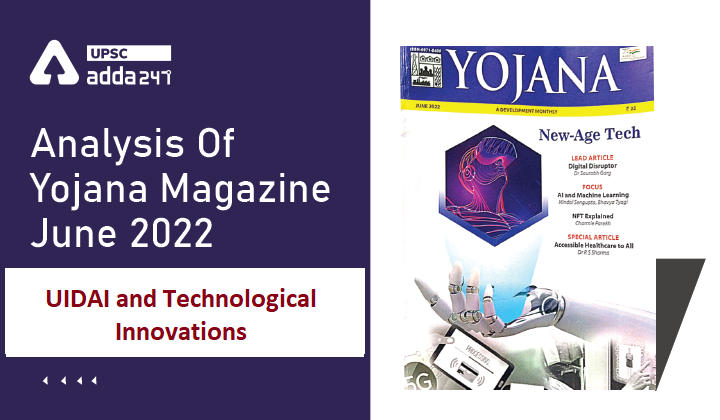Table of Contents
Yojana Magazine is a very important and indispensable source for UPSC Civil Services Exam Preparation. Here, we come with ”Analysis Of Yojana Magazine” which covers the monthly Yojana Magazine keeping in mind the demand of UPSC, particularly from the topics of important government schemes.
In ‘‘Analysis Of Yojana Magazine,” we cover each and every topic of the Yojana edition of a particular month and provide an easy-to-understand gist.
This topic-wise analysis is prepared from June 2022 edition of the monthly Yojana Magazine.
Introduction
- The Aadhaar System is built on a sound strategy and a strong technology backbone and has evolved into a vital digital identity infrastructure.
- Aadhaar, being a unique digital ID – provides a powerful platform for authenticating a resident anytime and anywhere which is in line with the vision of the UIDAI.
- The purpose of Authentication is to enable residents to prove their identity and for service providers to confirm that the residents are ‘who they say they are’ in order to supply services and give access to benefits.
What is Aadhaar?
- Aadhaar number is a 12-digit random number issued by the UIDAI (“Authority”) to the residents of India after satisfying the verification process laid down by the Authority. Any individual, irrespective of age and gender, who is a resident of India, may voluntarily enrol to obtain Aadhaar number.
- Person willing to enrol has to provide minimal demographic and biometric information during the enrolment process which is totally free of cost.
Technologies that have been adopted by UIDAI
- Unified My Aadhaar Portal.
- Multiple services on the mAadhaar mobile application.
- Use of secure QR Code and offline KYC.
- Virtual ID, Aadhaar Lock, Biometric Lock For security.
- Integration with Digilocker for consent-based fetching of residents’ documents.
- Extensive use of AI/ML.
- State-of-the-art UIDAIs own private cloud infrastructure.
- Indigenous development of Automatic Biometric Identification System(ABIS).
- Integration with ISRO.
- Inspection Portal for automatic inspection of aadhaar centres.
- Research is underway for -Blockchain Technology, IoT, Confidential Computing, AI-Based Fraud Analytics, Quantum Resilient, and Cryptographic Solutions.
What are Biometric Devices?
- Biometric devices means the devices that are used for capturing the biometric data inputs i.e Fingerprint / Iris /both the information from Aadhaar number holders.
- These biometric devices fall under two categories viz. Discrete Devices, Integrated Devices.
- Discrete Devices: These type of devices refer to the class of biometric devices (Fingerprint/IRIS) that require connectivity to a host device such as PC/laptop/Micro ATM etc.
- Integrated Devices: The integrated devices have the sensor integrated into the device package i.e. phone/tablet etc.
Technology innovation in authentication
- Aadhaar authentication is the process wherein the Aadhaar number, along with other attributes,including biometrics, are submitted online to the Aadhaar system for its verification on the basis of information or data or documents available with it.
- The UIDAI has set up a scalable ecosystem for the purpose of instant authentication of residents.
- The Aadhaar authentication ecosystem is capable of handling tens of millions of authentications on a daily basis, and can be scaled up further as per the demand.
- The UIDAI has appointed a number of Authentication Service Agencies (ASAs) and Authentication User Agencies (AUAs) from various Government and non-Government organisations.
- Some Innovations:
- Face Authentication
- Iris Based Aadhaar Authentication
- Fingerprint Imafe Record Based Authentication
Security Mechanism of UIDAI
- Protection of the individual, and the safeguarding their information is inherent in the design of the UID project.
- From having a random number which does not reveal anything about the individual to other features listed below, the UID project keeps the interest of the resident at the core of its purpose and objectives.
Aadhaar Verification
Unique Identification Authority of India (UIDAI) has stated that the veracity of ‘Aadhaar’ can be easily established both in an online and offline mode as mentioned below:
- Online Mode- Age Band, Gender, State and last 3 digits of Mobile of an Aadhaar Holder can be verified by visiting https://myaadhaar.uidai.gov.in/verifyAadhaar by feeding the Aadhaar number.
- Offline Mode- Every Aadhaar card /Aadhaar letter/e Aadhaar has a Secure QR code printed on it, which contains demographic details( Name, Gender, Date of birth and address) as well as photograph of the Aadhaar number holder. Even if the Aadhaar card is tampered with by photo shopping another person’s photograph, the Information in the QR code is secure and tamper-proof as it is digitally signed by UIDAI.



 TSPSC Group 1 Question Paper 2024, Downl...
TSPSC Group 1 Question Paper 2024, Downl...
 TSPSC Group 1 Answer key 2024 Out, Downl...
TSPSC Group 1 Answer key 2024 Out, Downl...
 UPSC Prelims 2024 Question Paper, Downlo...
UPSC Prelims 2024 Question Paper, Downlo...




